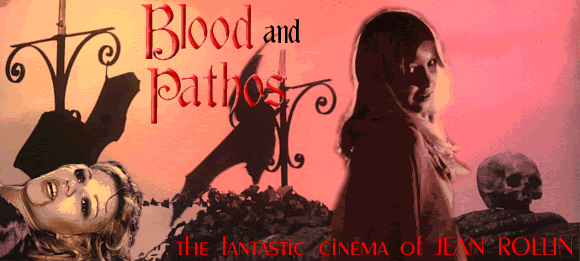

The growing appetite for international horror films in recent years hasbrought a number of previously unknown filmmakers to astonished U.S.viewers; just ten years ago, you could never find video copies of filmsby Jose Mojica Marins, Sergio Martino, or Pupi Avati, and even the DarioArgento, Jess Franco, and Lucio Fulci films were all heavily cut andhard to track down. Needless to say, things have changed. Of all the directors brought into the long deserved spotlight, noneare quite like French auteur Jean Rollin. His images are truly like noone else's; you easily know you're watching one of his films within thefirst two minutes. Many of his favorite visuals are certainly horrific- seductive female vampires in diaphanous gowns (or less), decayinggothic castles, unnatural candy colored lighting, and of course,startling splashes of blood. However, the underpinning sensibility isthat of a pure artist, a playful twentieth century mentality thatdelights in juxtaposing unlikely images to create either delight orutter disorientation in the viewer. His personal obsessions areimmediately discernable after sampling even a couple of titles; desolatebeaches stretch on forever as they would to the eyes of a child; younggirls, usually sisters, tread together through shadowy chateaus,castles, and wide open fields; bizarre villains sport outlandishcostumes and makeup. For the uninitiated, Rollin's first widely released feature film inhis native country, Le Viol du Vampire (Rape of the Vampire),began life as a short film but was soon expanded into a full lengthblack and white symphony of the bizarre. It set off a firestorm ofcontroversy in France, causing critics to label his subsequent work bythe derogatory term "Rollinade" (which has since become an affectionateterm in the horror community). Rollin's subsequent titles were no lessoffbeat and striking; some of his best early work includes LeFrisson des Vampires (Thrill of the Vampires) (which has appearedin so many different versions no one seems to know its original runningtime anymore), the almost plotless Requiem for a Vampire (abouta pair of identical, blonde, pig-tailed twins who wind up as vampirefodder), and the sublime Lips of Blood, a jaw-dropping assemblyof beautiful, chilling, and erotic images connected to a man'sintersecting nightmares of incest and vampirism. However, Rollin hasalso proven himself outside the vampire realm; in two of his mostpopular titles, Raisins de la Mort (Grapes of Death) (agruesome tale of contaminated wine setting off a plague of zombies inthe French countryside) and the superb Fascination (about turnof the century women who ritually consume blood) introduced the iconicactress Brigitte Lahaie, who began in hardcore porn but became a firstrate scream queen and a dramatic/action actress in her own right.However, Rollin would top himself again with perhaps his best film,La Morte Vivante (The Living Dead Girl), in which the bond offriendship between two young women is tested when one of them turns upas a blood-consuming member of the undead. More recently Rollin hasdirected the avant garde short film Perdues in New York andLes Deux Orphelines Vampires, with more projects hopefully onthe way. While only La Morte Vivante has been widely availableto U.S. customers by way of an laserdisc special edition, his absencewill be remedied by the DVD releases of some of his most importanttitles by ImageEntertainment, thanks to their recent involvement with England'sRedemption Video. Mondo Digital had the opportunity to recentlyspeak with Rollin about his films both past and future, so click on theicons above and learn about this unique Gallic voice in the world ofmodern horror. Mondo Digital MainPage |
Rollin Interview |
LaserLogue |
ScoreLogue
